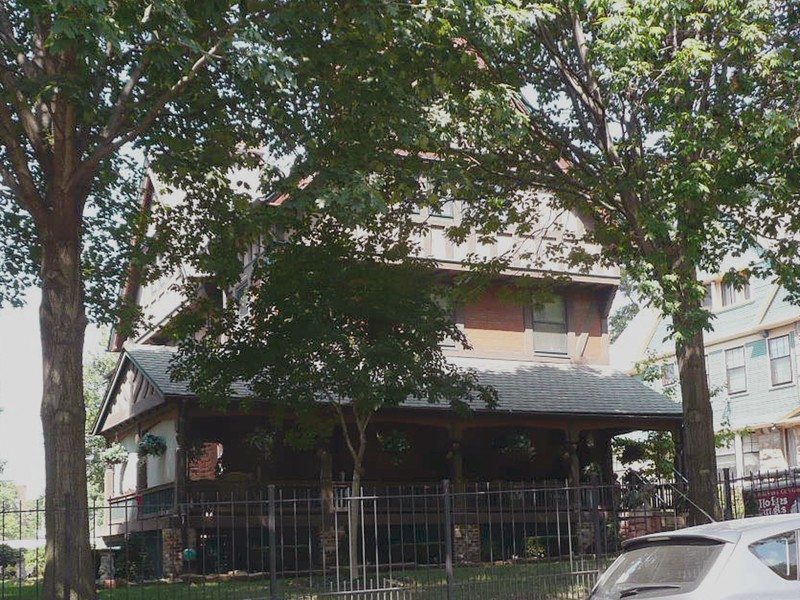William Baker and Mary Knight House
Introduction
Text-to-speech Audio
This Hyde Park home was completed in the summer of 1890 and home to the family of William Baker Knight, a civil engineer who died at age 42 just six months after this home's completion. In his short career, Knight established himself as one of the leaders of his field, designing canals, railways, bridges, sewer systems, and roads in New York, Washington D.C., and Kansas City. The house he built with his wife Mary was one of the first grand homes in Hyde Park, a neighborhood that catered to the upwardly mobile middle class and wealthy residents at the turn of the century.
Images
William Baker and Mary Knight House

Backstory and Context
Text-to-speech Audio
William Baker Knight, one of the nation's most accomplished civil engineers during the late nineteenth century (who designed much of Kansas City's early rail lines), built his large home in 1890. The exemplary Victorian Queen Anne style home features masonry and half-timbering, both uncommon treatments for this style. The house also contained several unique features, such as voice tubes that allowed room-to-room and floor-to-floor communication. William and his wife Mary built the home, but sadly, Knight also died in 1890 at the age of 42 from injuries incurred during a train crash.
William Baker Knight, born in New York City in 1848, developed into a nationally recognized civil engineer. He followed his early education at public schools by pursuing engineering in 1864 at the Rensselaer Polytechnic Institute in Troy, N.Y. He began practicing as an engineer in New York State in November 1867 and ultimately found work with The Poughkeepsie and Eastern Railroad, which hired him as an engineer in charge of fieldwork for the town and highway surveys on Staten Island. One of his early achievements involved constructing twenty miles of track in Connecticut, including a bridge that spanned 1100 feet over the Connecticut River. By 1871, he worked as an assistant engineer for the Brunswick and Albany Railroad, Georgia, and as a principal assistant engineer for the South Florida Railroad. In 1872, he accepted the position of transit man in charge of field operations for 300 miles of line for the New York, West Shore, and Chicago Railroad.
From 1874 to 1879, before he came to Kansas City, he worked high-profile jobs at the Washington D.C. Board of Public Works, New York City Public Works, and the Panama Railroad Company. In those years, he oversaw the construction of D.C.'s new streets and sewer lines and the extension of the Lake Erie, Evansville, and Southwestern Railroad in Indiana, among many other accomplishments. In 1879, he moved to Kansas City and established Knight and Bontecou, Civil Engineers, which gained a reputation as one of the leading engineering firms in the West. Among the Knight and Bontecou's many achievements, the duo laid out the Union Transit Company's Kansas City line, designed and constructed the Arkansas City Canal at Arkansas City, Kansas, and performed engineering work for the Union Depot Company in Kansas City, and completed twenty miles of double track for cable railways in Kansas City, including through the downtown region. The company also built an abundance of cable lines (for telegraph communication).
The Kansas City Mayor appointed Knight to the position of City Engineer in 1882, which he served for three years. As city engineer, he oversaw the laying of the first cedar block pavement in Kansas City. His many accomplishments in public works, urban planning, engineering, and railroad development gained him a reputation as one of the nation's leading engineers.
In 1886, Knight married Mary Frye. The couple went on to have two children (a son and a daughter). Four years later, construction finished on the couple's now-historic home in what became an affluent area of Kansas City; the Knight house stood as the first on its block, part of the newly platted neighborhood of Hyde Park. The neighborhood was promoted as a place located far enough away from the dirt and noise of the city, yet close enough for residents to enjoy the convenience (roughly eighteen minutes ride by cable to downtown Kansas City). The couple built the home at the southernmost end of Kansas City's trolley line, an appropriate location for this locally and nationally known engineer. The house contains innovative touches, such as voice tubes linking the first story with rooms on the second and third story and coal-burning fireplaces. As well, instead of doorknockers, Knight installed electric doorbells.
Knight never enjoyed the home he built as he died in a train crash in 1890, six months after construction finished. Mary lived in the home for another year before selling the property. Between 1892 and the early 1940s, the home sat vacant at times in between changing ownership. Mildred Morrison purchased the house in the early 1940s and owned it for four decades before selling it in 1984. Today, it remains a residential property as it has been for more than 130 years, and it survives as a monument to William Knight and his many engineering accomplishments.
Cite This Entry
Powers, Mathew and Clio Admin. "William Baker and Mary Knight House." Clio: Your Guide to History. April 11, 2022. Accessed March 29, 2025. https://theclio.com/tour/2016/15/reverse
Sources
"About Hyde Park: Kansas City’s Historic Hyde Park." Hyde Park Neighborhood Association. Accessed August 16, 2021. https://hydeparkkc.org/about-hyde-park/.
Ford, Susan Jezak. "Nomination Form: Knight. William Baker and Marv. House." National Register of Historic Places. archives.gov. 2003. https://catalog.archives.gov/OpaAPI/media/63819110/content/electronic-records/rg-079/NPS_MO/03001054.pdf.
By Mwkruse - Own work, CC BY-SA 3.0, https://commons.wikimedia.org/w/index.php?curid=42383345

